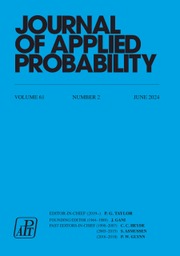No CrossRef data available.
Article contents
Sufficientness postulates for measure-valued Pólya urn sequences
Published online by Cambridge University Press: 28 March 2025
Abstract
In a recent paper, the authors studied the distribution properties of a class of exchangeable processes, called measure-valued Pólya sequences (MVPSs), which arise as the observation process in a generalized urn sampling scheme. Here we present several results in the form of ‘sufficientness’ postulates that characterize their predictive distributions. In particular, we show that exchangeable MVPSs are the unique exchangeable models whose predictive distributions are a mixture of the marginal distribution and the average of a probability kernel evaluated at past observations. When the latter coincides with the empirical measure, we recover a well-known result for the exchangeable model with a Dirichlet process prior. In addition, we provide a ‘pure’ sufficientness postulate for exchangeable MVPSs that does not assume a particular analytic form for the predictive distributions. Two other sufficientness postulates consider the case when the state space is finite.
Keywords
MSC classification
Information
- Type
- Original Article
- Information
- Copyright
- © The Author(s), 2025. Published by Cambridge University Press on behalf of Applied Probability Trust


